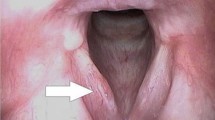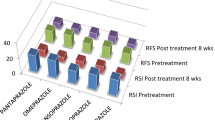Abstract
The study was under taken to know the prevalence of reflux signs in an individuals with throat complaints on the basis of reflux finding score (RFS) and quantitatively assess the effect of treatment. A cross-sectional study was done to evaluate the presence of laryngo-pharyngeal reflux signs in patients visiting ENT clinic with throat or voice problems in central India. There were 80 patients included in the study from 2017 to 2018 individuals. They were questioned regarding their symptoms. Their pharyngeal findings on rigid 70° laryngoscopy were viewed and RFS was made. The patients were reviewed at monthly intervals. Laryngopharyngeal reflux changes were seen in 36 of the 80 patients (45%). The reflux was graded as per the reflux finding score. The score ranged from 7 to maximum of 17 out of 26 in the patients with LPRD. Majority of the patients the score decreased with lifestyle changes and pantaprazole twice daily. There was poor response in 5% (4) patients, who were then advised to undergo upper gastro intestinal endoscopy for further assessment. Laryngopharyngeal reflux has become a very common entity in urban lifestyle. On careful examination the signs can be picked and assessed with the RFS, which is a very useful tool to grade and reassess patient on subsequent follow up.



Similar content being viewed by others
References
Vakil N, van Zanten S, Kahrilas P, Dent J, Jones R (2006) The Montreal definition and classification of gastroesophageal reflux disease: a global evidence-based consensus. Am J Gastroenterol 101:1900–1920
Koufman JA (2002) Laryngopharyngeal reflux is different from classic gastroesophageal reflux disease. Ear Nose Throat J 81(9 Suppl 2):7–9 (PMID: 12353431)
Farrokhi F, Vaezi MF (2007) Laryngeal disorders in patients with gastroesophageal reflux disease. Minerva Gastroenterol Dietol 53(2):181–187 (PMID: 17557046)
Belafsky PC, Postma GN, Koufman JA (2001) Laryngopharyngeal reflux symptoms improve before changes in physical findings. Laryngoscope 111(6):979–981. https://doi.org/10.1097/00005537-200106000-00009 (PMID: 11404607)
Pearson J, Parikh S, Orlando R, Johnston N, Allen J, Tinling S et al (2011) Review article: reflux and its consequences—the laryngeal, pulmonary and oesophageal manifestations. In: Conference held in conjunction with the 9th international symposium on human pepsin (ISHP) Kingston-upon-Hull, UK, 21–23 April 2010, Aliment Pharmacol Ther 33(Suppl. 1):1–71
Qadeer MA, Swoger J, Milstein C, Hicks DM, Ponsky J, Richter JE, Abelson TI, Vaezi MF (2005) Correlation between symptoms and laryngeal signs in laryngopharyngeal reflux. Laryngoscope 115(11):1947–1952. https://doi.org/10.1097/01.mlg.0000176547.90094.ac (PMID: 16319603)
Carroll T, Fedore L, Aldahlawi M (2012) pH Impedance and high-resolution manometry in laryngopharyngeal reflux disease high-dose proton pump inhibitor failures. Laryngoscope 122:2473–2481
Savarino E, Bazzica M, Zentilin P, Pohl D, Parodi A, Cittadini G et al (2009) Gastroesophageal reflux and pulmonary fibrosis in scleroderma: a study using pH-impedance monitoring. Am J Respir Crit Care Med 179:408–413
Sifrim D, Dupont L, Blondeau K, Zhang X, Tack J, Janssens J (2005) Weakly acidic reflux in patients with chronic unexplained cough during 24 hour pressure, pH, and impedance monitoring. Gut 54:449–454
Tutuian R, Mainie I, Agrawal A, Adams D, Castell D (2006) Nonacid reflux in patients with chronic cough on acid-suppressive therapy. Chest 130:386–391
Katz P, Gerson L, Vela M (2013) Guidelines for the diagnosis and management of gastroesophageal reflux disease. Am J Gastroenterol 108:308–328; quiz 329
Bardhan K, Strugala V, Dettmar P (2012) Reflux revisited: advancing the role of pepsin. Int J Otolaryngol 2012:646901 (PMC free article)
Samuels T, Johnston N (2010) Pepsin as a marker of extraesophageal reflux. Ann Otol Rhinol Laryngol 119:203–208
Sun G, Muddana S, Slaughter J, Casey S, Hill E, Farrokhi F et al (2009) A new pH catheter for laryngopharyngeal reflux: normal values. Laryngoscope 119:1639–1643
Martinucci I, de Bortoli N, Savarino E, Nacci A, Romeo SO, Bellini M, Savarino V, Fattori B, Marchi S (2013) Optimal treatment of laryngopharyngeal reflux disease. Ther Adv Chronic Dis 4(6):287–301. https://doi.org/10.1177/2040622313503485
Belafsky PC, Postma GN, Koufman JA (2001) The validity and reliability of the reflux finding score (RFS). Laryngoscope 111:1313–1317
Author information
Authors and Affiliations
Corresponding author
Ethics declarations
Conflict of interest
Author declares that there is no conflict of interest.
Rights and permissions
About this article
Cite this article
Kirti, Y.K. Reflux Finding Score (RFS) a Quantitative Guide for Diagnosis and Treatment of Laryngopharyngeal Reflux. Indian J Otolaryngol Head Neck Surg 70, 362–365 (2018). https://doi.org/10.1007/s12070-018-1350-3
Received:
Accepted:
Published:
Issue Date:
DOI: https://doi.org/10.1007/s12070-018-1350-3




